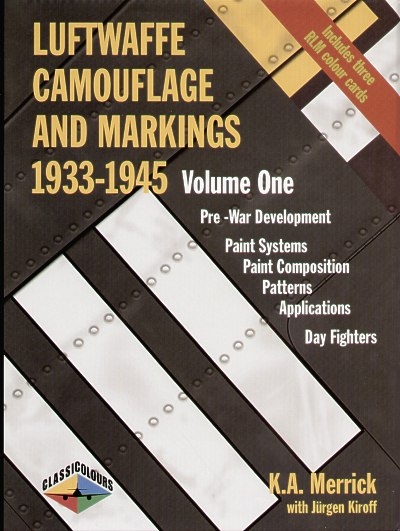|
S u m m a r y
|
| ISBN: |
1 903223 38 5 |
| Media: |
Hard cover; 224 pages; 303
mm x 226 mm in portrait format, more than 300 photos; three
loose-leaf cardboard sheets with actual paint chips |
| Price: |
£50.00 or USD$89.95 plus shipping, online from Classic
Publications
or available worldwide from specialty
bookshops |
| Review Type: |
First Read |
| Advantages: |
Excellent technical and
historical summary of pre-war and wartime German paint
manufacturing and standards; description of application of
paints and camouflage patterns; good coverage of Luftwaffe Day
Fighter camouflage and markings; discussion and conclusions are
strongly supported by official documentation wherever practical;
carefully selected photos (including many in colour) with
helpful captions; actual paint samples supplied on separate
cardboard charts; numerous new and interesting interpretations
of a number of finishes. |
| Disadvantages: |
No specific
explanation/description of colour charts (RAL, FAS and Fleiglack
standards in particular); a couple of paint chips stuck together
on my sample. |
| Recommendation: |
Highly Recommended |
Reviewed by Brett Green

HyperScale is proudly supported by Squadron.com
Ken Merrick is one of the world's foremost researchers on the
subject of Luftwaffe camouflage and markings. His 1980 title, "The
Official Luftwaffe Guide to Painting German Aircraft", co-written
with Thomas Hitchcock, remains a favorite reference source for
modellers and Luftwaffe aficionados, regularly commanding hundreds
of dollars when a copy appears for auction on Ebay.
 It
is therefore no exaggeration to state that Mr Merrick's latest
title, "Luftwaffe Camouflage and Markings 1933-1945 Volume 1", has
been long awaited and eagerly anticipated. It
is therefore no exaggeration to state that Mr Merrick's latest
title, "Luftwaffe Camouflage and Markings 1933-1945 Volume 1", has
been long awaited and eagerly anticipated.
The first installment of this two Volume set comprises 224 pages
between its hard covers. The text is organized into seven chapters
plus Appendices, but the book can be neatly divided in two distinct
parts. The first six chapters, approximately 124 pages, set the
scene with a wide ranging description of the German aircraft paint
industry, its development, paint composition, patterns and
applications. Chapter 7, comprising 75 pages, describes the
camouflage and markings of Luftwaffe Day Fighters.
The first six chapters draw heavily on official documentation to
support their conclusions. The entire book is also packed with
wartime photos that are used to illustrate various points in the
text. Official camouflage patterns are also included for a wide
variety of aircraft.
As might be expected, the focus shifts from documentation based
to situational based when dealing with the chaotic final two years
of the war. Chapter 6 covers these critical years, including
discussion of the confusion surrounding the transition and
implementation (or otherwise) of the late war Luftwaffe colours 81,
82 and 83. The author also describes the use of existing paint
stocks, trials and introduction of selective bare metal finishes on
various aircraft components, the appearance of the green-blue lower
surface colour, and also offers some suggestions about the reasons
for variations - official and otherwise - of camouflage shades.
The section on Day Fighter camouflage is quite comprehensive, and
uses wartime photos to supply case studies for the application of
camouflage patterns and colours. All the photographs have been
carefully chosen and the captions are often fascinating and thought
provoking. Many of the photographs are in colour.
This Volume concludes with Appendices describing export colours,
interior colours and extracts from official documents.
Three loose leaf cardboard colour charts are also supplied with
actual paint samples. Two of the charts contain common RLM colours
up to farbton 73 (although not all the colours are on both
charts); while a third chart supplies several RLM shades plus FAS,
metallic, RAL and Fleiglack samples. Although the RLM colours are
fairly self explanatory, I would have liked to see a description or
key for the last chart.
The lack of any colour profiles defies the fashion of recent
publications, but this book does not suffer from their absence.
Camouflage diagrams and wartime photos with their helpful captions
combine very effectively to illustrate the detailed text.
.
Ken Merrick's "Luftwaffe Camouflage and Markings 1933-1945 Volume
1" is not a lightweight picture book that can be flicked through and
quickly digested. It is a carefully thought out tome, well supported
by wartime documentation and photographic case studies, that
attempts to tackle this complex subject in the face of receding
history and an increasing desire for easy answers.
I think that it is worth quoting the author's own words on page
18:
"For those who require only the simplest answers to
specific moments in time and place, the writer offers his
apologies in advance and would direct them to less complex
works. The danger of dipping into the following text at random,
and reading it in isolation of contributing factors may prove
confusing or even contradictory at times. Unfortunately, complex
processes usually are not concomitant with simple answers -
Luftwaffe camouflage and markings fall squarely within those
parameters."
This book will be an essential companion for serious Luftwaffe
enthusiasts and modellers who are interested in the background and
application of German aircraft paints in WWII.
Highly Recommended.
Thanks to Simon of DLS Australia for the review
sample
"Luftwaffe
Camouflage and Markings 1933-1945 Volume 1",
and other Classic books, may be purchased through
specialist bookstores worldwide or
from
Ian Allan Publishing website
Review Copyright © 2005 by
Brett Green
This Page Created on 20 April, 2005
Last updated
22 April, 2005
Back to
HyperScale Main Page
Back to
Reviews Page |
Home | What's
New | Features
| Gallery |
Reviews | Reference
| Forum
| Search